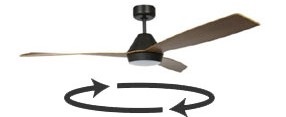A quality and reliable ceiling fan is always a worthy investment, especially during the hot summer months. When fall and winter come along, the fans quickly lose value in many households; hence they are locked in storage awaiting the next year.
This is because many people don’t know that fans can also be used during the colder months to keep your house warm.

All you need to do is understand how to manipulate the blade directions and angles, which is what this guide is about. This practice will help you save on the otherwise exorbitant electricity bills and boost the warmth generated by your furnace.
Which way should a ceiling fan turn in the summer?
Fans are designed to cool the air in the room; however, to make the most of this device, you need to know the exact fan direction in summer settings. Statistics show that using a fan correctly saves you up to 40% of air conditioning bills.

So, your ceiling fan direction during summer should be counterclockwise. This is, so it’s able to push as much cold air downwards and create a windy cooling effect.
However, there are numerous models of ceiling fans, all with different blade designs and features. This means the above explanation will not work for everyone. The only way to know which side your fan belongs to is to test and examine it.
To do this, stand directly beneath your fan. If the blades’ air movement creates a somewhat breeze on you, then the fan is set up correctly. If you don’t feel anything, then it means the settings are for ceiling fans in winter.
So adjust accordingly by hitting the reverse button either on the wall control or the remote.
What direction should a ceiling fan spin in winter?
You need to get a good-quality ceiling fan to hack using it during winter. Most cheap fans have no difference; no matter the side their blades rotate. Ceiling fan rotation for winter should be in the clockwise direction. This type of air manipulation is what is referred to as reverse convection.

In short, the cool air will rise upwards, and the warm air will descend downwards. This leaves you with a warm environment that allows your heaters to kick in less often. Statistics show that using a fan during winter saves you 15% off electricity bills.
Also, you need to note that you will still get a minimal windy effect when the fan speeds are set too high, hence thwarting your efforts. Set the speeds to the lowest setting and lower your thermostat temperature.
If your house has very high ceilings like that of a cathedral, do not set the fan clockwise. This is because the fan is way too high to create a windy effect. For you, the ceiling fan rotation for summer and winter is the same.
Enjoy a better climate while saving costs
In a bid to make houses more energy-efficient, you need to always be on the lookout for hacks like correct fan settings. The above ceiling fan rotation tips for winter and summer will save you a lot of money and help you keep track of your carbon footprint.
Related Guides
